Brief
Executives working in today’s electricity sector might rue the ancient curse, “May you live in interesting times.” The sector is undergoing an unprecedented transition that is bringing tremendous challenges, but also a wide range of opportunities.
In the past, the sector was able to provide affordable, secure and reliable electricity by attracting investors with low-risk, stable returns. Over the past decade, policy initiatives have added the imperative to reduce the sector’s carbon output and its dependence on imported fuels by generating more power from renewable sources and encouraging more efficient use of electricity.
A great deal of money has already been spent on this transition—about $3 trillion since 2000, according to the International Energy Agency. But more—at least another $8 trillion—will be required over the next 25 years to complete it. To get there, the sector will need to remain viable and attractive for investors, which has become more difficult in recent years in some parts of the value chain.
The Future of Electricity, a recent initiative by the World Economic Forum, in partnership with Bain & Company, identifies significant issues that policy makers and regulators will need to address to attract this investment and also details ample opportunities for incumbents and new businesses. (See the below, “Policy and market recommendations from the Future of Electricity report.”)
Much of the new investment will need to be made in traditional thermal generation or generation from renewable sources (see Figure 1). Another large portion will be invested in transmission and distribution (T&D), including smart grids that improve capacity and capabilities, and interconnections between grids.
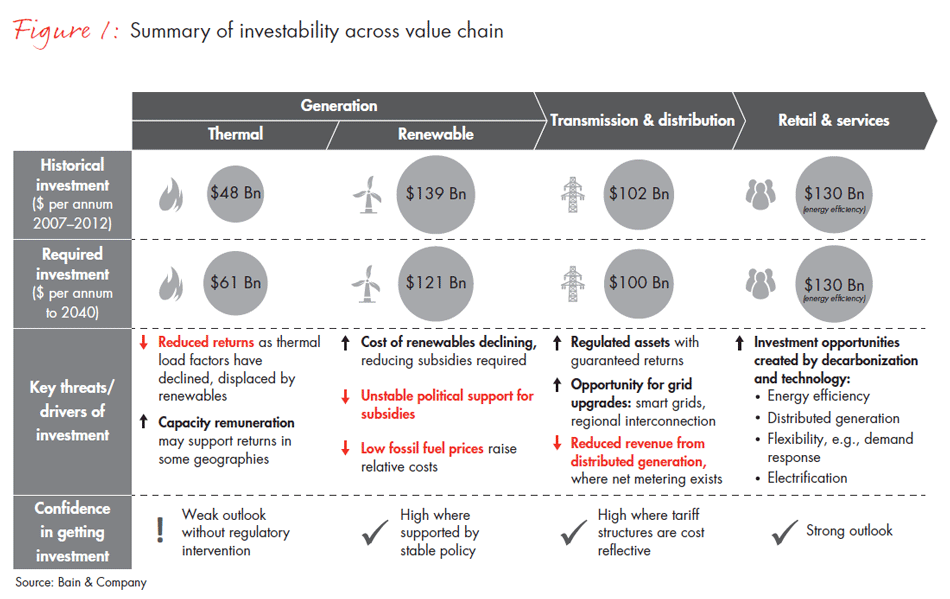
New business and investment opportunities are also emerging in services that are much closer to electricity customers. These include services and products that help customers manage and reduce their electricity consumption or help them generate their own power.
Electricity executives are working on several fronts to shape the sector and their own organizations, so they can take advantage of the wide range of new possibilities. They continue to work with policy makers and regulators to find the best ways to balance risk and return to attract the required investment. Together, executives and regulators should identify the most efficient paths for achieving policy goals while designing markets that send clear signals to investors, with a minimum of intervention. With those structures in place, executives will be able to read the market signals appropriately and allocate their investments to the most promising areas that most closely align with their capabilities, goals and risk profiles. Investors and executives will also continue to work with financial institutions and others to develop new types of investment structures to finance ventures with differing risk profiles across the electricity value chain.
Centralized generation: Getting the mix right
Despite the rise of distributed generation in some markets— as much as 40% of capacity in Germany and about 5% in the US—traditional systems (central generation, conventional T&D lines, retail delivery) will still deliver most of the electricity 20 years from now. Even by 2040, forecasters predict that only about one-quarter of generation will come from non-hydro renewables (mostly solar, wind, biomass), and that will be a mix of centralized and decentralized. The rest, aside from some industrial cogeneration of heat and power (CHP), will come from centralized power generation.
The risk-return profile of centralized generation, however, is changing. As technologies evolve and the generation mix diversifies, it becomes more difficult to predict the optimal composition of a power generation portfolio. At the same time, new entrants are increasing competition, eroding the stability of the incumbent generation markets.
Meanwhile, returns are declining, particularly for thermal generation. Growth has been undermined by energy efficiency and distributed generation. As low-marginal-cost renewables have contributed to overcapacity, load factors and wholesale prices have declined in many markets. In the US, returns on capital invested in utilities fell 1.3 percentage points from 2006 to 2013 due to flattening or even declining demand and decreased load factors, despite lower gas prices. In the EU, returns fell 4.8 percentage points from 2006 to 2013 as a result of falling demand, significant overcapacity, reduced load factors and declining wholesale prices.
Executives also need to help policy makers shape the market, sending clear signals for their desired mix. Currently, electricity markets suffer from a lack of effective market mechanisms, particularly with regard to carbon pricing. The existing carbon pricing mechanisms are conceptually simple, but also politically and practically complicated to implement. For example, the EU Emissions Trading System (ETS) failed to deliver a carbon cost sufficient to drive adoption of renewable energy. In generation, the increasing penetration of low-marginal-cost and intermittent renewables in Europe has lowered wholesale prices and raised the debate over whether markets that remunerate generators and T&D operators solely based on load can ensure reliability without interventions. Without clear signals, policy makers risk shortfalls in electricity supply, such as we have seen in the UK.
To remain viable for new investment, power generators will need to ensure they are targeting the right mix in their generation portfolio. Turbulence in some markets is already leading incumbents to reevaluate the role of central generation in their businesses. E.ON has divided its central generation plants from the rest of its business and plans to spin it off. Centrica is seeking to sell some of its centralized generation assets, while RWE has taken another tack, centralizing the management of its generation fleet.
Power generators can also take “no regrets” actions like improving the efficiency of their generation assets by reducing external costs, seeking out new revenue sources and reorganizing to increase efficiency. (For more details, see the Bain Brief “Power struggle: Making the most of generation assets in turbulent times.”) They can also improve their position by investing to increase the flexibility of thermal plants.
Transmission and distribution: Ready for change?
T&D will require another $2 trillion through 2035. About 60% of that will be needed for refurbishing existing lines. New lines will also be required to connect renewable generation sources like offshore wind or solar arrays, which are in remote locations, and to connect the base-load and backup generation to support intermittent renewables. New policies and technologies that enable smart grids may further increase investment requirements.
The traditional economics of the grid have been disrupted in some countries due largely to decentralized generation, which has reduced the load on the grid, and net metering. Net metering allows customers to trade back the electricity they generate (through solar panels, for example) against the electricity they consume. It provides an effective incentive for investment in decentralized generation, but it does not adequately reflect the value or cost of a grid connection.
To help meet the sector’s needs, transmission and distribution providers should be in discussions with regulators about incentives and regulatory structures to support the rollout of renewables, without undermining investments in T&D capacity and smarter grids. This is typically a more complex discussion than the regular negotiation of rate base and rates of return, and agreements can often take years to achieve (see Figure 2). Proposals are coming not only from utilities but also from regulators: New York State’s Reforming the Energy Vision initiative aims to move the sector toward a more decentralized model. The changes across the electricity sector are likely to result in new remuneration models for T&D operators: from rates based on kilowatts delivered per hour to models that recognize not only the electricity delivered, but also the value of the grid’s role as a backup for microgrids and other distributed energy systems.
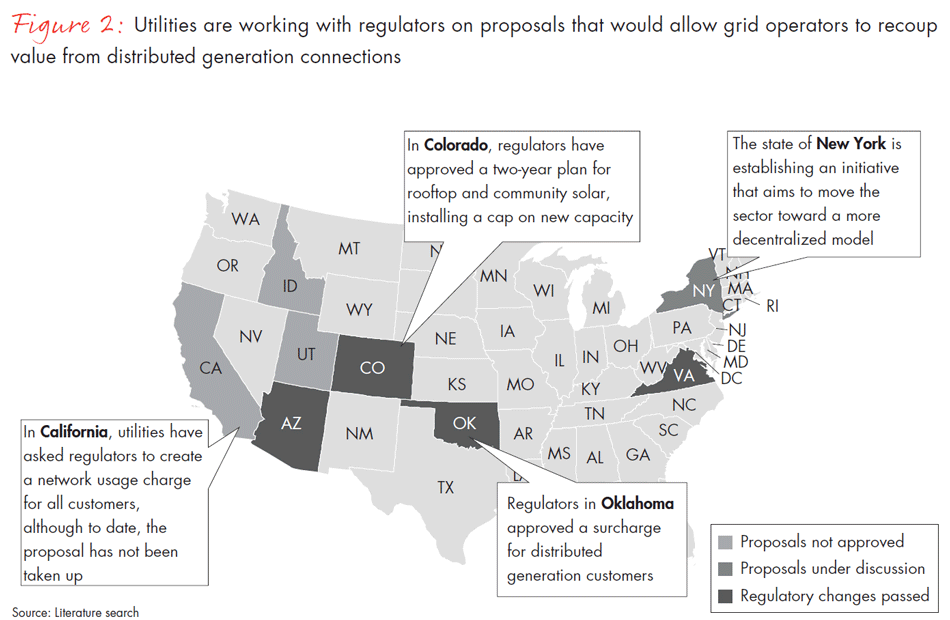
T&D operators will also want to hone their capabilities as some face the largest investment and network upgrades in more than a generation. In addition to the technological and financial challenges, many will face talent shortages of both experienced engineers and field forces.
Retail: A digital story
Retail electricity businesses, which are not as capital intensive as generation or transmission and distribution, are not suffering from the same investment viability concerns. Instead, electricity retailers are on a journey of digitization—following in the footsteps of companies in media, finance and other industries—which will require them to develop new products and services to keep up with competitors.
Smart meters and a wealth of new data about electricity usage create new possibilities to help customers manage and control their power consumption. Better data could help create new pricing models that depend on time of day or day of week to encourage customers to use appliances when demand is lower—free usage in the evenings, for example. And an unusually high level of overnight electricity use might prompt an automatic email alerting the customer (“you may be leaving too many devices on standby”) and suggesting ways to conserve.
Electricity retailers will have to upgrade their customer interfaces and billing systems to take full advantage of frequent and more accurate metering; this could improve their collections percentages and reduce write-offs. If done right, all of these things could improve the customer experience and generate greater brand loyalty.
Energy services: New capabilities
Customers are becoming more than consumers in the electricity value chain. Increasingly, many are “prosumers,” who produce or generate their own electricity and feed it back into the grid. The sector’s value chain is evolving (see Figure 3): Decarbonization policies; the need for greater flexibility; increasingly sophisticated digitization technologies; and customers’ eagerness for greater control over their ability to generate, monitor, exchange and consume electricity, with varying needs at different times of day, are bringing about this change.
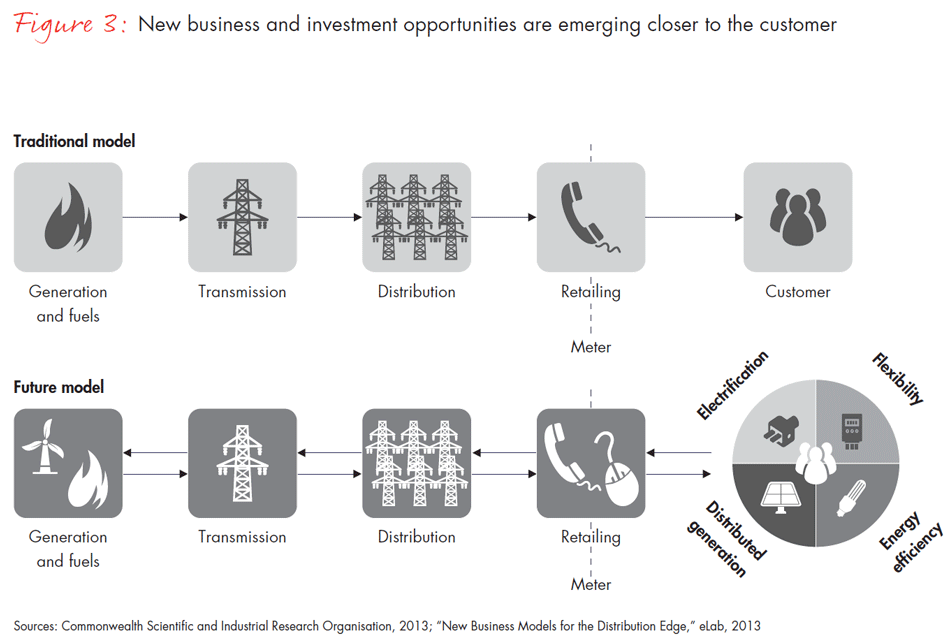
Incumbent utilities and new entrants are considering these new consumer needs, as well as other new opportunities, to identify whether and where to play given technology trends, regulatory schemes and linkages with their core business. As in other industries that have faced policy goals limiting or cannibalizing their business, such as tobacco or alcohol, executives will want to work with regulators to ensure their companies can evolve to remain competitive in a rapidly changing sector.
These opportunities require new capabilities (see Figure 4). In distributed generation businesses—like rooftop solar—a key requirement is the ability to craft and deliver a package that includes design, financing and installation, as well as the capability to collect grants and subsidies that make the venture economically positive. Selling smart thermostats requires designing an ergonomic and attractive consumer product, along with product branding and marketing.
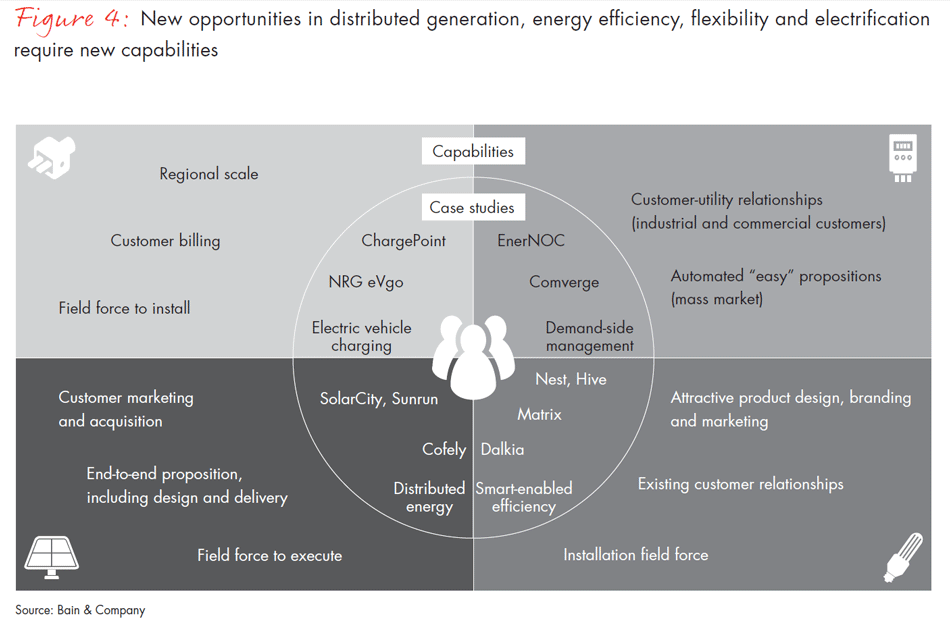
Most of these capabilities are quite different from those that have served traditional electricity retailers so well, such as the ability to meter and send out bills monthly or manage large field forces with infrequent customer contact. This is one reason that many new entrants, which don’t have to manage legacy organizations and have defined their capabilities specifically for these opportunities, have been at the forefront of these markets.
But incumbents have advantages, too, including large customer bases with long-standing relationships (often, but not always, as a trusted brand) and an experienced field force. Some utilities are moving into the energy efficiency business, either under their own brands or with subsidiaries and spin-offs. Their large customer base and field forces are well suited to delivering energy services to a wide range of customers. Cofely, a part of GDF SUEZ, and Dalkia, owned by EDF and Veolia, are two such subsidiaries. In some cases, utilities may want to partner with smaller firms that have closer ties with local businesses and that are sometimes better positioned to excel in installation, operations and maintenance.
Given the new capabilities required, utilities are taking a variety of routes to enter these new spaces (see Figure 5).
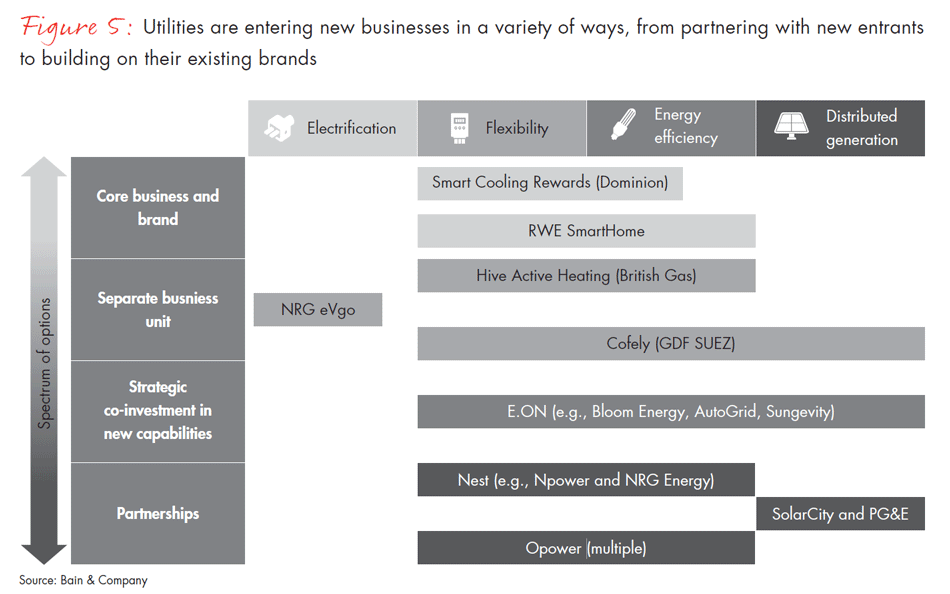
Some companies can enter using their own brand, as several US utilities have done with demand-response services and as RWE did with its RWE SmartHome services.
Where different capabilities or branding is required, some utilities have created or bought separate business units with their own recruitment profile, skill set and brand identity. Consider again Cofely and Dalkia, two subsidiaries of larger utilities.
A third approach is strategic co-investment in smaller companies with unique capabilities or technologies to which utilities would like access. In most cases, they have taken a minority stake and have not integrated acquisitions into the traditional core business.
Finally, there are several examples of utilities providing new services to existing customers by partnering with specialist providers such as Nest Labs, which is now expanding outside the US with its smart thermostats, and Opower, which offers a suite of customer engagement services.
New opportunities like smart-home services or distributed energy management will probably not compensate for losses in their core power generation businesses. And the ideal combination of businesses will vary across markets and according to each company’s existing portfolio and capability gaps. Each company will need to navigate its unique strategy, reacting to competitors—as other firms do the same.
Investors: Innovating and evolving
The traditional mix of investors is evolving in response to the electricity sector’s changing risk-reward equations. In power generation and T&D, utilities and developers are partnering with infrastructure and pension funds, allowing them to invest directly in assets, particularly renewables with low-risk, price-guaranteed returns.
Closer to the customer, a new set of investors with different risk appetites is moving to take advantage of new opportunities. In distributed generation, private equity firms, hedge funds and private households are all investing in technology and deployment.
New types of financing are evolving to support investment. Green bonds—bonds certified as promoting environmental sustainability by one of a number of entities, each with their own criteria—have had a successful year, including a record €2.5 billion bond issue by GDF SUEZ. Yieldcos—tax-efficient, low-risk investment structures—have become increasingly popular in the US, as a way for utilities to attract investment in renewables. Their economic attractiveness hinges, however, on the continued growth of the renewables sector. Distributed asset securitization, which is a similar structure to that used to package mortgages into tranches in the 2000s, has played a role in the success of rooftop solar providers, like SolarCity, by lowering financing costs.
All of these challenges to the traditional models of the electricity sector—in generation, transmission and distribution, retail and related services, and financing—are forcing change while opening up significant new possibilities. New entrants have a clear runway, and they are taking advantage of positive consumer sentiment, generous subsidies and investor enthusiasm. But incumbents also have real opportunities, and significant advantages in their customer bases and experienced field forces, as they create new products, services and whole businesses.
Policy and market recommendations from the Future of Electricity report
During the World Economic Forum’s Annual Meeting 2014 in Davos, CEOs from leading utilities and energy technology companies discussed the challenges ahead for the electricity sector and identified the risk that some parts of the industry’s value chain may not attract the necessary investment. As a result, WEF launched the Future of Electricity initiative and worked with industry executives, policy makers and other stakeholders to define options for making the electricity sector more sustainable by increasing the viability of investments in mature markets.
The complete report, The Future of Electricity, is available online at weforum.org. Key recommendations for policy makers and regulators include the following:
Policy makers. Create policy frameworks that are efficient, stable and flexible, recognizing the inherently uncertain technological and economic environment we live in.
- Plot the most efficient pathways to policy objectives. Create incentives for “no regrets” investments, such as energy-efficient technologies, demand-response services and more-efficient networks and plants. Exploit the most efficient renewable resources within and across borders.
- Stabilize policy by building in flexibility and working to increase societal support. Recognize inherent uncertainties by investing incrementally. Communicate the value of investments to society. Reduce risk to investors by prohibiting retroactive policy changes.
Regulators. Provide clear direction to markets while minimizing interventions. Ensure clear, effective signals: Provide a clear, stable market signal on carbon pricing, for example, to create incentives for decarbonization.
- Reward efficiency, reliability and flexibility. Encourage the industry to develop generation and grid systems that can respond to volatile fluctuations in demand. Recognize the value of reliable grid capacity in network tariffs and regulatory frameworks.
- Create level playing fields across geographies, businesses and technologies. Harmonize incentives, encourage appropriate physical interconnection and remove unnecessary regulatory barriers to competition between incumbent utilities and new entrants.
While there are many debates about global energy policy and regulation, those areas of general consensus offer a clear path forward in the transition of OECD markets—a journey that will be watched carefully by developing nations.
Julian Critchlow is a partner with Bain & Company in London, where he leads the firm’s Global Utilities practice. Olga Muscat is also a partner in Bain’s London office. Joseph Scalise is a Bain partner in San Francisco; he leads the North American Utilities practice.




